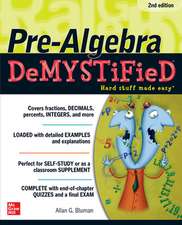Similarity, Self-Similarity, and Intermediate Asymptotics
Editat de G. Barenblatten Limba Engleză Paperback – 27 ian 2012
Preț: 632.45 lei
Preț vechi: 744.05 lei
-15% Nou
Puncte Express: 949
Preț estimativ în valută:
121.13€ • 124.79$ • 101.47£
121.13€ • 124.79$ • 101.47£
Carte tipărită la comandă
Livrare economică 22 februarie-08 martie
Preluare comenzi: 021 569.72.76
Specificații
ISBN-13: 9781461585725
ISBN-10: 1461585724
Pagini: 240
Ilustrații: XVIII, 218 p.
Dimensiuni: 152 x 229 x 13 mm
Greutate: 0.33 kg
Ediția:Softcover reprint of the original 1st ed. 1979
Editura: Springer Us
Colecția Springer
Locul publicării:New York, NY, United States
ISBN-10: 1461585724
Pagini: 240
Ilustrații: XVIII, 218 p.
Dimensiuni: 152 x 229 x 13 mm
Greutate: 0.33 kg
Ediția:Softcover reprint of the original 1st ed. 1979
Editura: Springer Us
Colecția Springer
Locul publicării:New York, NY, United States
Public țintă
ResearchDescriere
Professor Grigorii Isaakovich Barenblatt has written an outstanding book that contains an attempt to answer the very important questions of how to under stand complex physical processes and how to interpret results obtained by numerical computations. Progress in numerical calculation brings not only great good but also notori ously awkward questions about the role of the human mind. The human partner in the interaction of a man and a computer often turns out to be the weak spot in the relationship. The problem of formulating rules and extracting ideas from vast masses of computational or experimental results remains a matter for our brains, our minds. This problem is closely connected with the recognition of patterns. It is not just a coincidence that in both the Russian and English languages the word "obvious" has two meanings-not only something easily and clearly understood, but also something immediately evident to our eyes. The identification of forms and the search for invariant relations constitute the foundation of pattern recognition; thus, we identify the similarity oflarge and small triangles, etc.
Cuprins
1. Dimensional Analysis and Similarity.- 1. Dimensions.- 2. Dimensional Analysis.- 3. Similarity.- 2. The Application of Dimensional Analysis to the Construction of Exact Special Solutions to Problems of Mathematical Physics. Self-Similar Solutions.- 1. Strong Thermal Waves.- 2. Strong Blast Waves.- 3. Self-Similarity. Intermediate Asymptotics.- 3. Modified Problem of an Instantaneous Heat Source: Self-Similar Solution of the Second Kind.- 1. Modified Problem of an Instantaneous Heat Source.- 2. Derivation of the Basic Equation.- 3. Direct Application of Dimensional Analysis to the Modified Problem of an Instantaneous Heat Source.- 4. Resolution of the Paradox. Self-Similar Intermediate Asymptotics. Nonlinear Eigenvalue Problem.- 5. Numerical Calculations.- 4. The Problem of a Strong Explosion with Energy Loss or Deposition at the Front of the Shock Wave and the Problem of an Impulsive Load: Self-Similar Solutions of the Second Kind.- 1. Statement of the Modified Problem of a Strong Explosion.- 2. Direct Application of Dimensional Analysis to the Modified Problem of a Strong Point Explosion.- 3. Resolution of the Paradox. Intermediate Asymptotics.- 4. Qualitative Investigation of a Nonlinear Eigenvalue Problem.- 5. Numerical Calculations.- 6. The Problem of an Impulsive Load.- 7. Numerical Calculations. Self-Similar Asymptotics.- 8. Self-Similar Limiting Solution.- 9. Laws of Conservation of Energy and Momentum in the Problem of an Impulsive Load.- 5. Classification of Self-Similar Solutions.- 1. Complete and Incomplete Self-Similarity.- 2. Self-Similar Solutions of the First and Second Kinds.- 6. Self-Similar Solutions and Progressive Waves.- 1. Solutions of Progressive-Wave Type.- 2. Burgers Shock Wave-Steady Progressive Wave of the First Kind.- 3. Flame-Steady Progressive Wave of the Second Kind.- 4. Nonlinear Eigenvalue Problem.- 7. Self-Similarity and Transformation Groups.- 1. Dimensional Analysis and Transformation Groups.- 2. The Boundary Layer on a Flat Plate.- 3. Limiting Self-Similar Solutions.- 4. Rotation of Fluid in a Cylindrical Container.- 8. The Spectrum of Exponents in Self-Similar Variables.- 9. Stability of Self-Similar Solutions.- 10. Self-Similar Intermediate Asymptotics of Some Linear Problems in the Theory of Elasticity and the Hydrodynamics of Ideal Fluids.- 1. The Problem of the Equilibrium of an Elastic Wedge under the Action of a Concentrated Couple Applied at Its Tip.- 2. The Sternberg-Koiter Paradox. Intermediate Asymptotics of the Non-Self-Similar Problem.- 3. The Use of Self-Similar Solutions for Estimating the Stiffness of a Wedge.- 4. The Flow of Ideal Incompressible Fluid in a Corner—Self-Similar Solution of the Second Kind.- 11. Self-Similarities of the First and Second Kind in the Theory of Turbulence. Homogeneous Isotropic Turbulence.- 1. The Problem of Turbulence.- 2. Homogeneous Isotropic Turbulence.- 3. The Decay of Homogeneous Isotropic Turbulence for Negligibly Small Third Moments.- 4. The Decay of Homogeneous Isotropic Turbulence for Finite Third Moments.- 5. Locally Isotropie Turbulence.- 12. Self-Similarities of the First and Second Kind in the Theory of Turbulence. Shear Flow.- 1. The Wall Region of a Turbulent Shear Flow.- 2. Similarity Laws for the Atmospheric Surface Layer.- 3. Similarity Laws for Flow in a Turbulent Wall Region with Adverse Pressure Gradient.- 4. Unsteady Phenomena in the Viscous Layer of a Turbulent Shear Flow.- 5. The Regime of Limiting Saturation of a Turbulent Shear Flow Loaded with Sediment.- Epilogue.- References.










